Defending Against the Allied Bombing Campaign
Air Raid Shelters and Gas Protection in Germany
Recently the argument has been advanced that each of the crematoria at Birkenau was equipped with a gas-tight bomb shelter. The argument was first made in the Summer of 1996 by Arthur R. Butz, with respect to Crematoria II and III in his Vergasungskeller article.[1] In the Spring of 1997 the concept was extended to cover all of the crematoria in Birkenau in my article Technique and Operation of German Anti-Gas Shelters in World War Two [hereinafter, Technique].[2]
Although the identification of these spaces as gas-tight bomb shelters was corroborated in Technique by extensive reference to contemporary German civil defense literature, public acceptance of the thesis has been slow. Part of the reason, no doubt, is that the “Bomb Shelter Thesis” contradicts the work of Jean Claude Pressac and others, notably, Robert Jan van Pelt.[3] In addition we must recognize that the thesis, in either the Butz or Crowell variant, seems at first glance both unusual and even extraordinary.
But the argument for bomb shelters in the Birkenau crematoria seems extraordinary only because the scope of the German civil defense program is so little known. Hence, when the crematoria are identified as having had gas tight bomb shelters the first reaction of the skeptic will be, why would there be alterations for the crematoria to serve as air raid shelters? Why not other buildings? without recognizing that similar shelters were quite common in Germany, and, we believe it possible to show, also in the concentration camp system and Auschwitz-Birkenau in particular. So it should be clear that the argument for gas-tight bomb shelters in the Birkenau crematoria is strengthened to the extent that analogous structures can be shown to have existed both in the concentration camp system as well as in German cities.
The present article is an attempt to carry the argument for comparison and corroboration forward, in this case by supplementing the contemporary civil defense literature cited in Technique with secondary studies of German civil defense in World War Two, comprising both recent German studies as well as US government studies prepared in the immediate postwar period. The result will be the broader realization, widely recognized in the secondary literature, that gas tight bomb shelters were a common feature on the wartime German civilian and concentration camp landscape.
We will begin by reviewing the rules and recommendations for German civil defense, and will find that the precautions the Germans took for bomb and gas attacks were extensive. A review of the actual types of structures will show a wide array of constructions, including adaptations of natural geologic formations, existing structures for secondary bomb shelter use, covered trenches for concentration camp internees, and a particular emphasis on above ground structures, all of which were designed to defend against both bombs and gas attacks. Provisions for gas-tight doors, including those that would lock from the outside, reinforced concrete roofs, including those with brick ventilation shafts, and gas-filtering ventilation systems will be shown to have been quite common, according to both the documentary evidence and the oral testimony of the men, women, and children who took part in the large civil defense network. In addition, we will note the particular emphasis placed on chemical decontamination facilities, which would usually be sited in only a few dual-purpose locations in a city, and which, along with the specially trained decontamination crews, would also be used to combat vermin and the spread of infectious diseases, including typhus.
In the course of such a review we cannot pass by the opportunity to describe some of the circumstances whereby the Germans used this civil defense apparatus to maximum advantage, overcoming terror, destruction, and massive casualties to survive and endure. For if the story of the civil defense precautions in the concentration camp system is little known, so too has the German people's battle for survival in the Allied bombing campaign been largely ignored.
Part 1: Civil Defense in Germany
1.1. Regulations
It was generally accepted after World War One that aerial bombardment would be a feature of any future war, and that civilian populations would be targets. “Strategic” bombing in this sense was a kind of indirect warfare, meant to rupture the enemy's economy or demoralize its population so that the enemy army would be forced to capitulate.[4] Such indirect warfare is a classic feature of siege warfare as well as naval blockade, the last circumstance may explain why Great Britain became the leading practitioner of strategic area bombing in World War Two. A famous expression of Britain's point of view was made by Stanley Baldwin in the House of Commons on November 10, 1932:
“I think it is well for the man in the street to realize that there is no power on earth that can protect him from being bombed. Whatever people may tell him, the bomber will always get through. The only defense is in offense, which means that you have to kill more women and children more quickly than the enemy if you want to save yourselves.” [H43f, S12]
Recognizing such a position, Germany made attempts to protect itself passively from future air attack even in the 1920's, even though active defense – searchlights, flak guns, and so on – were forbidden by the Treaty of Versailles. [S11] Already in 1931 the Ministry of the Interior was issuing guidelines for civil defense, and in 1932 the first issue of the Vorläufige Ortsanweisung für den Luftschutz der Zivilbevölkerung was issued, which, by war's end would comprise 12 chapters with numerous comprehensive attachments. [S12]
After Hitler took power Germany began preparing mobilization plans, and these included provision for the defense of cities. The mobilization plans of the Luftwaffe included a special attachment breaking down the cities of Germany into Civil Defense Areas (Luftschutzorten) of Class I, II, and III. [S14] The difference in classes was primarily a matter of local control, inspection, and preparedness. The controls would be in the hands of the Luftschutzleiter (civil defense leader) usually the mayor or sometimes the local Nazi gauleiter. The 104 cities in Class I (or LSO-I) included all cities with large populations, and other cities that were considered vital for war industries. Thus Hamburg, Berlin, Munich, and Dresden were naturally LSO-I: but so was Siegen, with a population of 60,000. Siegen's inclusion was based on its location near the Ruhr, its status as a garrison city, and its war important industries.[S16]
It would be tedious to go over the voluminous regulations governing the civil defense establishment in Germany from 1933 forwards, but there are two documents that deserve special attention: The Code of Practice for Building Shelters [Bestimmungen für den Bau von Luftschutz Bunkern] and the orders pertaining to the Luftschutz Führer Sofort Programm, that is, the Fuhrer's Emergency Air Raid Program, usually referred to as the LS-Führerprogramm.
The United States, in its postwar surveys, stressed the detailed nature of the Code and its provisions.[CD152f] In fact, the Code also laid down basic guidelines in which civil defense had to be viewed. The basic concepts turned on the collective nature of the enterprise: any program was to cover the whole city, and the program had to be worked into any urban development programs. The Code gave preference to above ground shelters, because underground shelters were costlier. In addition, it specified various details, such as the number of gas-locks for entry (preferably, two), the width of entries, the size of the staircases, the need for washrooms, first aid rooms, and so on. [CD153]
If the Code underlay Germany's civil defense approach, the LS-Führerprogramm of November, 1940, stressed the same points with greater detail and greater urgency. By the time of its issuance, Germany was reconciled to a long air war, therefore the details of the program were meant to be comprehensive and prescriptive, as a listing of some of its provisions show:
- For buildings (municipal buildings, dwellings, lots) in which there are up to now none or inadequate air raid shelters, do it yourself air raid measures will be adopted.
- Existing or newly constructed streets or transportation paths (e.g., subways and tunnels) are to be adapted for the construction of underground and bombproof air raid shelters.
- The openings to the outside in existing air raid shelters are to be removed and at the same time connections are to be made [to other shelters] with collapsible fire walls.
- New public air raid shelters are to be constructed, and existing air raid shelters are to be made, as bombproof as possible.
- All new constructions, particularly in buildings for the armaments industry, are henceforth to be equipped with bombproof air raid shelters. Such shelters are to have the same priority as the structure being built itself. [S23f, N327ff]
- Für Wohngebiete (städtische Gebiete, Siedlungen, Laubenkolonien), in denen bisher keine oder unzureichende Luftschutzräume vohanden sind, sind behelfsmäßige Luftschutzmaßnahmen zu treffen.
- Vorhandene oder neu zu bauende Verkehrsstraßen oder Verkehrsanlagen (z.B. Untergrundbahnen und Tunnelbauten) sind für den Bau unterirdischer, bombensicherer Luftschutzräume auszunutzen.
- Die in Luftschutzräumen vorhandenen Öffnungen in den Außenwanden des Gebäudes sind zu beseitigen unter gleichzeitiger beschleunigter Durchführung der gesetzlich geordneten Brandmauerdurchbruche.
- Neu zu errichtende öffentliche Luftschutzräume sind bombensicher zu bauen, die vorhandenen öffentlichen Luftschutzräume sind – soweit möglich – auf Bombensicherheit zu verstärken.
- Bei allen Neubauten, insbesondere bei den Bauten der Rüstungsindustrie, sind von vorneherein bomensichere Luftschutzräume auszuführen. Sie sind in die gleiche Dringlichkeitsstufe wie die Bauvorhaben selbst aufzunehmen.
A few clarifications to the program are necessary. The openings to the outside that needed to be closed has to do with the demonstrated insecurity for some emergency exits; this would lead eventually to the filling in of emergency exit passages with sand, or boxes of gravel, or even the filling in with a narrow wall. Second, the Brandmauerdurchbruch, or collapsible fire wall, was meant to connect a series of buildings, such as one would find in large cities. Such an expedient would of course be useless in situations where a building was isolated. The most striking thing about the LS-Führerprogramm, aside from the extensive construction that followed after it was issued, is the fact that it was global: all buildings, new or old, were to be equipped with bomb shelters.
1.2. Organization of Civil Defense in Cities
The organization for Civil Defense in Germany was extremely widespread. The Reichsluftschutzbund (hereinafter, RLB)[5] numbered 12 million members by 1939 [B13], and it is only reasonable to assume that its numbers swelled as the war continued. Each city had a complicated hierarchy of positions and departments whose functions were clearly marked out.
The basic structure was the Sicherheits- und Hilfsdienst (SHD, Recue and Repair Service), which was further subdivided. The Sicherheitsdienst (S-Dienst) functioned as security and police in the event of air raids, the Feuerlöschdienst (F-Dienst) were the firefighting crews, the Instandsetsungsdienst (I-Dienst) were charged with technical and emergency repairs, including bomb disposal and the rescue of bombing victims, and the Sanitatdienst (San-Dienst) worked closely with the Red Cross and the municipal health authorities in handling all problems of health, emergency care, and hygiene that grew out of the bombing raids. There was even a special department devoted to veterinary care, with emergency stations for the care of draft animals and pets. [N46-143]
The final division of the civil defense forces was the Entgiftungsdienst or the Decontamination Service. The decontamination workers were normally attached to the firefighters, and indeed in Nuremberg they were amalgamated with the firefighters in 1940, so that the gas protection function of the E-Dienst became auxiliary [N77]. Already by 1939, Nuremberg, with a population of about 450,000, had 15 decontamination squads with 15 NCOs and 300 men, in addition, there were 56 gas testers (Gasspürer) attached to the central authority. [N48] The role of the gas testers were to follow up on any suspicions of gas usage and take samples to one of 25 gas testing labs. Other fixed sites related to the work of the Decontamination Service included five decontamination centers with 5 NCOs and 20 men, and five centers for the decontamination of materials (Sachenentgiftungsanstalten) also divided among 25 personnel. The location of these stations is difficult to establish today but it is clear that they made use of existing locations that featured laundries and public bathing facilities [N78, CD164]. It seems probable also that the municipal disinfection center (several German cities possessed these) was earmarked for dual purpose[6]. The example in the city of Nuremberg can safely be extrapolated to Germany at large, not least because of the global nature of the US Strategic Bombing Survey's report which covers German gas protection measures in detail.[CD164f].
The members of the Decontamination Service throughout Germany were issued special protective clothing, including rubberized suits and boots, and, like other important personnel in the Civil Defense Program, had higher quality gas masks (some 12 million gas masks in all were distributed). [CD153,CD164] The US Strategic Survey Final Report considered it significant that the production of this anti-gas warfare gear continued until the end of the war.[CD164] In addition, the members of the decontamination squads received special training: of the 150 hours of instruction for these auxiliary firefighters, no less than 25 1/2 hours were devoted to chemical warfare.[N78] On the other hand, in order to reduce anxiety, the average citizen received only about a half hour of chemical warfare instruction. [CD165]
In addition to the decontamination squads, gas testers, the various fixed sites and their work crews, gas protection also included trucks and even ships equipped with cleansing apparatus, and chemicals and decontamination equipment, including trucks and supplies held in reserve to be sent to afflicted areas.[CD164f]
As to the application of gas protection features to air raid shelters, it was a given that bombproof also meant gasproof, as one author remarks: “Particular attention had to be given to the entrances to the bunkers. Each bunker had to have at least two entrances and each entrance had to be equipped with a gaslock. It was understood that bombproof meant proof against gas bombs!” [S40] and the US Strategic Bombing Survey stated “All buildings and public shelters constructed or modified to house air-raid protection activities were gas proof.” [CD164] Further evidence of the pervasive nature of gas protection in Germany can be found in Technique.
1.3. Types of Shelters and Equipment
Secondary sources pertaining to the civil defense procedures of individual cities are a good source of information on the types of shelters erected. But an extremely useful summary of such structures can also be found in an essentially contemporary publication of the US government, the Civil Defense Division Final Report, issued in its second edition in January, 1947.
The most basic shelter was the home shelter, or do it yourself shelter (Behelfmäßiger Luftschutzraum) such as one would find in private homes or apartment buildings. Since some 22 million Germans lived in 58 cities of 100,000 or more [H128], and there were 104 cities with priority civil defense classification (i.e., Luftschutzort I) [S15], we can imagine that there must have been literally hundreds of thousands of cellars that were fitted out with at least minimal bomb and gas protection. Here, the numerous “how-to” articles in periodicals such as Gasschutz und Luftschutz indicate the extent of the preparation. According the the US Strategic Bombing Survey, such shelters were subject to inspection and approval by the local authorities [CD155] and had to meet the following specifications: (1) at least rudimentary gas-proofing, (2) at least one emergency exit (usually to an adjoining cellar through a Brandmauerdurchbruch, or collapsible fire wall), (3) the sealing of all other openings to the outside, and (4) in some cases rudimentary struts of wooden beams or brick. [CD155] The costs for such private shelters was frequently subsidized by the government [CD155] : a wise move, since during the heavy raids the line between private and public shelters was frequently erased. As can be imagined such basic basement shelters provided only marginal support in the heaviest raids, but the insistence on gas proofing is certainly significant in evaluating the importance and pervasiveness of anti-gas measures.
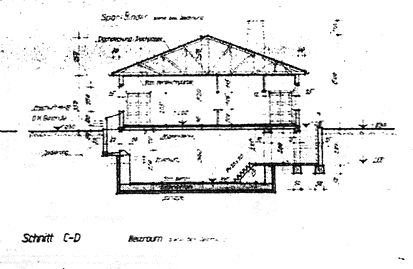
Graphic 1-3: Plans for a basement bomb shelter
A secondary category involved semi-public shelters which included schools and other municipal buildings. These were probably the most numerous of the various dual purpose shelters that served a public function; the US Strategic Bombing Survey specifies that they were equipped with gas-tight steel doors.[CD156] The problem with such converted shelters is that in some parts of the country, notably in the East and South, the building of communal shelters was delayed until late in the war, precisely at the point when building materials were most difficult to obtain. For example, Bavaria was long called the “Air Raid Shelter of Germany” on the understanding that it would not be bombed because of its distance from Britain. This assumption also led to the “Kinder Land Verschickung” a program in which children were evacuated from the North and West to the South. [US214] But from 1943 onwards all parts of the country would be bombed, and this probably explains the variability in the children's death toll, ranging from 10% in places like Hamburg and Nuremberg to 30% in cities like Darmstadt (see discussion below) because the children in the latter locations would not have been evacuated. Acceptable bomb and gas protection seem to have been widely available in converted shelters, as we shall see, but given the nature of the firestorm raids from 1943 onwards these would be of little help; cities like Munich, Augburg, and Dresden, were seriously affected by a lack of preparedness.
Of the dedicated public shelters, there were several types. Probably the most numerous of these were the trench shelters, such as one would find in the labor camps and concentration camps, these will be discussed in more detail later. Stollen were also found, and were essentially semicircular tunnels bored into a hillside, although often downtown underground bunkers would mimic the structure of Stollen. Since the vertical protection would depend on the height of the hill being bored into, we can imagine that they were quite secure, the main problem with such shelters could only be built where the lay of the land would support them. And there were occasional design lapses: one Stollen in Stuttgart, designed to hold 1,000, was notorious for lacking any restrooms. [S99]
Another common shelter, particularly in the cities, were large Luftschutzbunkern. Sometimes these involved the expansion of existing basements, or the digging of sub-basements. The floor plans for some of these shelters are mind-boggling in size, one that was inspected could hold 10,000 people. [CD157] Although priority was given to above ground shelters, the Germans ended up building many underground because of the lack of space, particularly in the centers of cities. [CD157] These were usually long, flat structures with flat roofs of reinforced concrete. Forced ventilation was standard, with standard Schutzraumbelüfter which were operated by electricity or by hand. Air intakes (Entlüftungsrohren) would usually be equipped with a gas-tight flap, as drawings indicate, [S77] sometimes the air intake would have a large and heavily sloped brick chimney, which, due to the slope, would occupy a mass many times greater than the aperture. [N569] It was apparently not unusual to use vent pipes for camouflage purposes. [CD162]
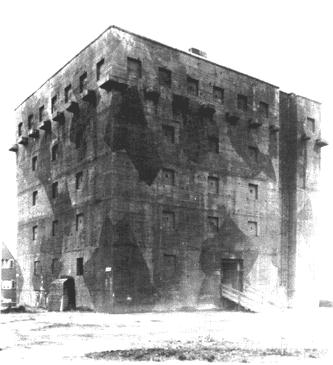
Graphic 1-4: A Hochbunker, or above ground bomb shelter
The large Hochbunker or above ground bunker was a German innovation that had no counterpart among the Allies. They were usually large concrete blocks built above ground and designed, like the Luftschutz bunkern, for multiple use: for people, important documents, artworks. Eventual peace-time use was envisioned for the Hochbunkern: indeed, in Hamburg many of these would be converted to office blocks after the war. [G69] They could be classed in various categories, including those that were provided with false roofs and painted-on windows that looked like gigantic chateaux, others that resembled squat skyscrapers with bricked in windows, still others that were round and faced with brick like the keep of a castle, and still others that looked like tapered towers. [S26ff, CD157f]
Although above ground shelters would seem particularly vulnerable because they were exposed, in practice they seem to have worked quite well. Since they were of concrete, they were not set ablaze, and since they were detached from other buildings they were not as directly affected by other burning buildings; hence the effects of heat or gases would not be as great. In the Hamburg raids of late July 1943, the second to last of which created the famous firestorm, only 100 people in above ground shelters perished, largely as a result of two direct hits on smaller structures. Considering that more than 50,000 people were killed that night and that over eleven hundred tons of high explosives were expended that seems a remarkably low total.
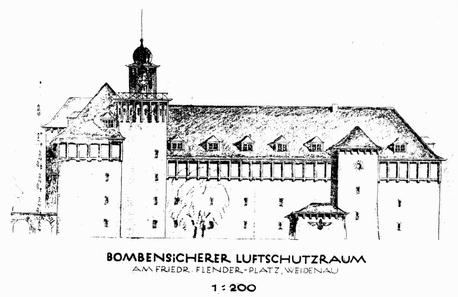
Graphic 1-5: Bomb shelter design, perhaps an attempt at disguising the purpose.
Perhaps one of the most unusual public air raid shelters was the Parkhöhle in Weimar. The Parkhöhle is a long jagged series of caves that underlay the city, several hundred meters in length, caused by water cutting through the rock formations. Long a tourist attraction, the Parkhöhle was converted to bomb shelter use late in the war, with some brick strutting done, as well as the provision of some other equipment. Because of its size, it was not felt necessary to ventilate its long corridors. The caves were also the site of extensive archaeological work by Johann Wolfgang Goethe and his son: the ethnographic museums of Weimar today still display their finds of ancient bones and other materials from the Old Stone Age. [P19ff,49]
As the discussion in Technique has already noted, ventilation in the air raid shelters was a problem insofar as it had to provide sufficient air per person (11 cubic feet per minute), had to provide temperatures in the acceptable range (24 C to 17C), and provide for humidity control. [CD158] In addition, the more secure shelters would be flooded with refugees in the event of severe raids. Overcrowding was always a problem.
It is difficult to reconstruct the number of shelters or the types of shelters built before and during the war, but various indications from the secondary literature provides a number of clues. It is known, for example, that Hamburg had over 2,000 public shelters for about 500,000 persons out of a population of over 1 million. [G69] Wuppertal, with a population of 400,000, built or converted over 100 shelters. [S98] Since Hamburg was one of the better prepared cities in the Reich, it is a safe inference that the rest of the residents were distributed in smaller home shelters and LS-Kellern, the colloquial name for the cellars of apartment buildings adapted for bomb shelter use. [N442] Dresden, on the other hand, had no dedicated public shelters, and only a few converted public shelters, yet home and apartment protection appears to have been up to standard. [D166f]
A detailed study of the city of Siegen provides information that we could extrapolate to the rest of the Reich. Under the LS-Führerprogramm, over 10 million RM was spent in the construction of 17 large public shelters, another 6 million for 8 Stollen, and close to another million in the conversion of 100 or so existing buildings to semi-public shelters. For a total outlay of over 17 million Reichsmarks, Siegen was able to provide adequate public shelter for about 20% of its population of 60,000, the rest falling back on home and cellar shelters. [S86]
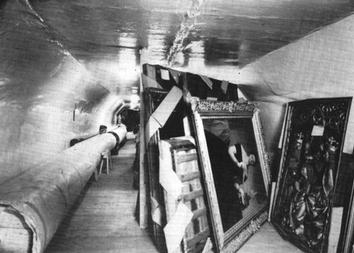
Graphic 1-6: A bunker for the storage of artworks in Nuremberg
There is also the case of Nuremberg. Early in the course of the LS-Führerprogramm, four shelters were designed for a cost of 3.6 million RM, even though the city began the war with dozens of public shelters. [N385] In 1943, the budget called for 52 new public shelters, the improvement of 294 old shelters, and the strutting and splinterproofing of of 3,600 home shelters for a cost of one and a half million RM.[N450] But neither in Nuremberg, nor in any other city, was funding, principally by the government, ever lacking – “Geld war genug da” – the money was always there. [N385] Further data on Nuremberg indicates that in 1942 there were 13,500 Kellerräume, that is, shelters for home and apartment dwellers. [N446]
Considering that there were over 12 million in the Luftschutzbund in 1939, that over 22 million Germans lived in 58 cities highly vulnerable to air attack (over 75 cities were essentially leveled by the RAF alone) [H374f] we can easily arrive at the conclusion that the program built thousands of dedicated public shelters, tens of thousands of semi-public conversions, and hundreds of thousands of home and cellar shelters at a total cost of billions of Marks.
1.4. German Civil Defense in Practice
The test for the German civil defense system came when the bombs started to fall. In spite of the careful planning, many precautions would not function in firestorm conditions. Then survival became a matter of luck, desperate courage, or strong leadership among the RLB Feldwebeln (sergeant majors), and fire wardens.
Under normal conditions the system seemed to operate well enough, with the usual precautions functioning normally. Thus one man would recall his boyhood experiences:
“I was a Hitler Youth messenger. As such, I was stationed at an air raid shelter bunker built both above ground and underground. When an air raid alarm sounded, we had to be there on time and open the bunker with the “block leader”, a party official who was responsible for the street. We had to care for the children, give them milk, and so on, if the alarm lasted a long time. […] The block leader or the women from the Nazi's women's organization sent around and handed out toys to the children and light sedatives to the adults. And the louder the attack got outside, the quieter it got in the bunker.
“The underground shelters were more like 'tube bunkers.' When you came through the steel door, fitted with rubber around the edges to make it airtight, you entered a diagonal hallway. This hallway was joined by three or four tube-like hallways perpendicular to it. Each of these, in turn, was a separate bunker. Air was pumped through each tube by machines which we Hitler Youth operated. That was one of our jobs. My duties also involved running messages from one bunker to another if the telephones went dead. We were outfitted with gas masks, steel helmets, etc. We had to go out at all times, even when the bombs were falling. I was 13 years old at the time.” [V211]

Graphic 1-6: A messenger boy in Hamburg who didn't make it through the firestorm. Very little remains of his body except a partial skeleton.
The above not only indicates the ordinariness of underground shelters, gas tight steel doors, and hand-cranked ventilators but also the integral role that women and children played in civil defense. One woman, in Dresden, describes surviving the American daylight raid after the famous firestorm:
“Normally, there were only 20 to 25 of us down in the cellar. But now, with many people off the street, including those who'd stopped over at our house, there were about 100 of us. Nevertheless, no on panicked – we were too numb and demoralized from the night before. We just sat there. The attack rolled closer, and then a bomb hit. It was like a bowling ball that bounced, or jumped perhaps, and at that moment the lights went out. The whole basement filled with dust. When the bomb carpet reached us, I crouched in a squatting position, my head between my legs. The air pressure was immense, but only for a moment. The rubber seals on the windows and the steel doors probably helped to absorb some of the impact. Someone screamed, and then it was quiet. Then a voice shouted, 'It's all right, nothing's happened.' It was the shelter warden.” [V231]
The above quote is informative in a couple of ways. It describes the typical gas tight seals on steel doors and windows. Such fixtures appear to have been common, even in Dresden, where virtually no large public shelters were especially built. [S99f,D166f] In addition, the role of the shelter warden in maintaining calm in the shelters is suggested. Indeed, it appears in several cases that the survival of thousands if not tens of thousands depended on the leadership and resource of the Feldwebeln (Sergeant Majors) Branddirektors (Fire Wardens) and the roving rescue squads of the SHD. The experiences of Sergeant Major Schäfer and Fire Warden Bey of the Hamburg RLB, as related to Gordon Musgrove for his Operation Gomorrah, are both typical and extraordinary. [G71f,73f,91f]
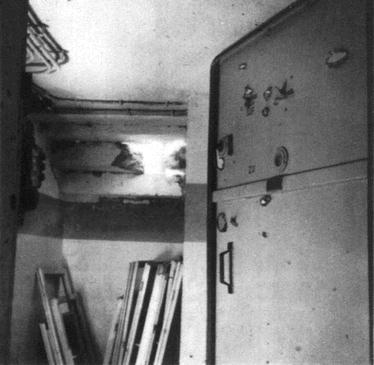
Graphic 1-7: A gas tight door for an air-raid shelter at Nuremberg
Schäfer was bombed out of his own apartment the day before the firestorm and had moved down the street to take up residence. When the firestorm raid began, he withdrew to the shelter of his new building, along with about 400 others. Over the course of the next half hour or so, he was led to make several trips out of the shelter into the flames, in order to determine the extent of the damage, from which he determined very early on the need for immediate evacuation. And here we encounter a common theme in shelter rescues: the need for forceful and even brutal leadership to save lives.
In Schäfer's case, his shouted demand for evacuation was greeted with fear and apathy; a reaction often cited in the air war literature. Schäfer's response was immediate: he grabbed the first two people near the exit by the scruff of their necks, dragged them up and out into the flaming street, and took them down to the corner to point out the way to safety in a nearby park. He repeated this exercise several more times, leading out by force a number of women and their children, which in turn brought everyone else out. When everyone had exited the shelter, he followed behind. On the way, he broke into a building that was not yet in flames, rescuing another party there, then made several dashes into the street to save women whose clothing had caught fire, passed out and was revived by some his people, retreated to the park with them, found temporary relief from a water tower, and finally, after several hours, was rescued with his full complement several blocks further away. There seems little doubt that without Schäfer's energetic leadership his party would not have survived, for the building from which they escaped collapsed minutes after his departure. What makes his self-control and presence of mind even more remarkable is that the last person to leave his shelter was his wife, and and as she did so she handed him their three month old child.
At this point it is necessary to pause and understand why there would be so much reluctance to leave the shelters. Most of the city raids were fire-raisers and several culminated in firestorms. Outside one had to contend with exploding bombs (including delayed action bombs), bomb splinters, falling masonry or entire buildings, and wooden roofing and construction beams that would fly around in the storm winds like matchsticks. In addition, all commentators make reference to a kind of continual shower of sparks, using metaphors like “swarms of fiery bumblebees”, or “blizzards of red snow”: these sparks could not only burn and blind but could also set one's clothes on fire. Finally, there was the heat, the gusting winds that would whipsaw back and forth and create clouds of sparks and debris at intersections, and which would reduce many trying to escape to crawling on all fours. Under these circumstances the difficulty in breathing was terrible, oftentimes one finds the comment “the air just wouldn't come” and similar sentiments. [US22] One warden, standing outside his shelter, was seized with a terrifying premonition of his own death, and not long after, suddenly passed out. Mercifully, he was right outside of a Hochbunker, and was dragged back in to safety. [G98] Another survivor describes falling to the ground and being forced to breathe off the pavement during the firestorm, burning his lips and mouth in the process. After an hour and a half the crisis had passed. Dead people were laying all around him. [G111f] In the Dresden raid, a survivor described a group of young girls who finally took the risk to dash across a courtyard and open a gate that would allow them to escape from the fires. Yet, as they were struggling with the gate, a building nearby collapsed, killing all of them. [D170] Seeing or hearing of such situations no doubt led many, and particularly women, women with children, and the elderly, to forsake the frightening uncertainty outside for what they believed would be the comparative security of the bunker. And these people rarely survived.
The leadership and professionalism of the air raid crews were of particular importance during firestorms, for here the elaborate systems of precaution frequently broke down. Collective protector ventilation systems might start bellowing smoke; emergency exits and shutters might crash in from the impact of bombs and offer no more protection; fire walls might be broken down in an effort to escape only to bring in lethal fire and smoke. Here again the human element made the difference between life and death.
Fire Warden Bey was another air raid leader in Hamburg. When the firestorm raid on Hamburg began, he was walking around the block, gathering up stragglers, but he too was soon forced to retreat to his shelter. Within a matter of minutes the street was ablaze and the shelter was becoming overcrowded with people from outside or from other shelters that had failed, some of whose clothes were already smoldering, others who had ripped them off to avoid the flames. The ventilation system soon broke down and the lighting soon failed; and, while he had no real hopes of fixing it, Bey made a shrewd display of instructing a few men to work on it, hoping that that would placate his anxious crowd and give them hope. Meanwhile, Bey and one of his NCO's went out on a number of patrols looking for help or safety. No clear escape route was found, nor did they find any emergency squads, who were roaming the blazing city in trucks, but they did find some water which they carried back to the bunker, which by now was extremely overcrowded. A series of cracks made in the connecting walls with other cellars did not lead to safety either, but brought even more dazed survivors into the shelter.
Going out into the street one more time, Bey finally flagged down a Major of the SHD with a rescue party and organized an evacuation. Returning to his shelter, Bey found that his people had given up all hope, but finally he was able to coax a few to follow him out so that he could explain the plan. No sooner had he stepped onto the street to encourage the others to join him, when two adjoining buildings collapsed, knocking him down and covering him with dust and debris. Meanwhile, his observers panicked and dashed back to safety. Bey got to his feet and returned to the shelter, and finally succeeded in goading and hectoring his people into the street. One by one the people from the shelter stepped out, encouraged by an exhausted Bey, forming a human chain down two streets and into a park. After inspecting the shelter one last time, he followed behind where he found all of his people in safety. Clearly the tenacity and perseverance of Fire Warden Bey was instrumental in their survival, but so too were the roving squads of the SHD, who abandoned their role of fire monitoring and fire fighting early on in order to save as many lives as possible. In this particular case, the lives of more than 700 were spared.
A particularly harrowing example of rescue concerns the city of Brunswick, which was bombed on October 15, 1944. Here the breakdown concerned what in retrospect would seem both foolish and tragic: the tendency of some shelter doors to be locked and bolted from the outside to prevent panicked civilians from rushing outside prematurely. The raid began at 2:30 in the morning and had developed a minor firestorm in the city center within 45 minutes. But this same area contained eight large bunkers and public shelters which housed 23,000 people. It was impossible to get through because of the firestorm, thus the rescue of these people depended solely on the ingenuity of the firefighters.
By 5 AM they were ready. Hoses were leapfrogged forward group by group, throwing up a “water alley” of protection for the next group that would detach its hoses, move forward, reattach, and create the next segment of the alley. Overcoming numerous complexities and failures, the firefighters finally got through to the bunkers at 7 o'clock the next morning, and “As the doors were unbarred and unlocked the rescuers heard the sound of 'many people talking quietly but nervously under their breath.'”[D64f] Then the survivors were led back to safety in an enormous human chain under the canopy of water.
There is a tendency when discussing war to expect the greatest demonstrations of leadership on the battlefield, and to view civilian victims as mere passive statistics, whose numbers are then manipulated for political purposes. Yet the narratives that have been recounted here remind us otherwise. The leadership, courage, and devotion to duty demonstrated by Sergeant Major Schäfer, Fire Warden Bey, and the Brunswick firefighters – along with many others – were in the finest traditions of any military organization. They were charged with saving as many lives as possible. At great personal risk, they accomplished that mission.
1.5. The Total Number of Victims
Yet it must be said that hundreds of thousands died. A usual figure for dead German civilians in the air war is about 593,000 – most round up to 600,000, others tend to argue for a lower figure, 300,000 to 400,000. [H11,DD171n] Rudolf Höß, the commandant of Auschwitz, insisted in his memoirs that “the total number of victims of the air war will probably never be found. In my estimation there were probably several million. The casualty figures were never made public. They were top secret.” [DD171] But the value of Höß' estimation is only a problem for those who consider him reliable in other areas.
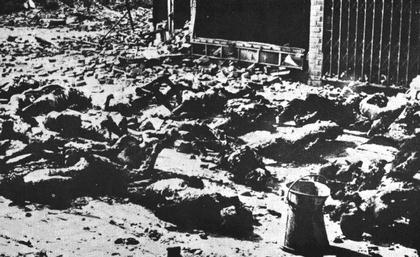
Graphic 1-8: Some of the tens of thousands of victims at Hamburg
The 593,000-600,000 figure, in turn, accepts a low estimate for Dresden, about 35,000. But it is doubtful that the figures for Dresden were so low. Hamburg, with a population of 1.2 million, suffered about 50,000 in the firestorm of July 29, 1943. But this was during the third of several attacks, and we should expect that many had fled from the city by the time of the third attack (the overall reduction in Hamburg's population was 43%). [G162] We know that the population of several cities was reduced as a result of air raids: Nuremberg, with a population of about a half million, had been halved by late in the war. [N445] In addition, Hamburg suffered its terrific casualties even though it was well equipped with thousands of shelters.
On the other hand, Dresden, with a pre-war population of 600,000, had been swelled with hundreds of thousands of refugees from the East, fleeing the Soviet army: its population at the time of the raid was probably comparable to Hamburg's at that city's zenith. Dresden was also struck by a firestorm: but it lacked almost all of the safeguards present in Hamburg. There were no large Hochbunkern in Dresden where people could wait out the storm. Death from asphyxiation would seem to be guaranteed.
Additionally, the hundreds of thousands of refugees in the city would have no way of orienting themselves or knowing how to escape: we can assume panic among many of them, and desperate retreat into overcrowded underground converted public shelters that would ultimately become death traps. Moreover, since Dresden had never before been seriously bombed, the population had neither fled, nor reduced in number, nor were they likely well versed in procedures that would save their lives: and only one, evacuation, would save them in the firestorm. On top of this, the second wave of British bombers was designed to bomb the center of the city at precisely the time when the maximum amount of aid would be in the streets trying to save the lives of the victims from the first wave: that percentage of losses must also be considered. Finally, the third blow by the Americans, next day, doubtless brought its casualties, along with the P-51 Mustangs who in several well documented instances strafed survivors, including Allied POW's, and clearly marked hospital wings. [D182,SF180]
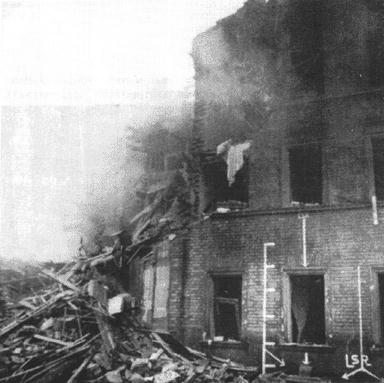
Graphic 1-9: The arrows point to shelter areas.
Finally, there is the matter of accurate counting due to the problems of cleaning up the destruction. It is well known that tens of thousands were burned on pyres in the center city, but bodies were still being recovered when the Soviets took over the city on May 8, 1945. And, as in the case of other cities, the recovery of dead bodies was not the highest priority: bodies were recovered when possible, and there were several cases after the war when the bulldozing of previously impassable remains turned up human remnants. [G167] Hans Voigt of Bielefeld, whose diary was employed by David Irving in his famous study of the Dresden raid, described his job in the gathering, identification, and disposal of remains: his final estimate was 135,000. [D208ff] While Hamburg is usually conceded to have caused 50,000 deaths, it is well to keep in mind that at the time the death toll was given out as between 30,000-40,000 [G167]: therefore, for people to assume similar casualties at Dresden would have seemed normal at the time. However, the conditions were definitely much worse in Dresden, for the reasons given, and therefore it seems likely that the casualty figures were much higher than Hamburg. In that case, Hans Voigt's projection seems reasonable, which would mean that the overall loss of life in the air war was in the neighborhood of 700,000.
Of the 15,802 bodies that were identifiable after the Hamburg firestorm, 6,072 were men, 7,995 were women, and 1,735 were children (children usually meaning pre-teenage). The percentages are thus 38.4% men, 50.6% women, and 11% children. [G167] For Darmstadt, which also experienced a firestorm but which was not as well prepared as Hamburg, there were 936 military deaths, 368 POW deaths, and 492 foreign laborer (i.e., forced laborer) deaths. Of 6,637 identifiable civilian dead (twice that many died) 1,766 were men, 2,742 were women, and 2,129 children. The percentages are thus 26.6% men, 41.3% women, 32% children. [H325f] Other raids show similar breakdowns, from which we conclude that the Allied campaign directed at German civilian morale killed mostly women and children.
There is a melancholy footnote to the Dresden raid, which, whatever its final counting, was surely the worst air raid in the European theater. As is well known, Churchill proceeded with the raid because he wished to make a demonstration of British might on the continent to the Soviets. [D148,D214] In the event, however, the raid, which was promised to hold up communications and transport for the front, and thus abet the Soviet offensive, was a failure: within three days, the marshalling yards were back to limited operation, and the city was not taken until after the war was over. [D177f] It is interesting to note that Churchill, in his memoirs, describes his determined effort to ensure that Eisenhower not capture the city. [D232] One can suggest a number of reasons for this, certainly the Americans crossed the Elbe at several other points. Popular perceptions of Dresden continue to be informed by Kurt Vonnegut's Slaughterhouse Five, a tremendously popular and widely read novel that describes the raid as “the greatest massacre in European history.” [SF101]. In opposition, we have the occasional little-read book which assures us that the bombing of Dresden was not a crime. As Vonnegut would say, so it goes.
1.6. After the Raids: The Nature of Victim Injuries
The morning after the raids was the time for cleanup and rescue, although even before the raids were over the people would be out in the street; women putting out fires, boys working water pumps for the firefighters, members of various crews and civilians organizing ad hoc rescue operations. The first priority was locating and rescuing survivors, as well as treating the injured, who, as in a real battle, would far outnumber the dead. Doctors had been privately informed that the threat of carbon monoxide poisoning was high, even in open areas, therefore they were told to give priority to unconscious victims ahead of those who had only been buried, burned, or with broken bones. [US24f] And needless to say as in regular battle the number of injuries would far exceed the dead; in Hamburg alone 37,439 were injured seriously enough to be counted, including many amputees and those with severe and lifelong burns. [G167]
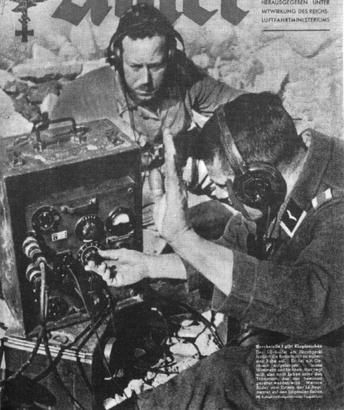
Graphic 1-10: Listening for signs of life under the rubble
Locating the living had its problems because if they were in shelters their location might have been covered by tons of brick and masonry. To help orient the crews, underground cellars were supposed to have white paint markings several meters up the side of the building pointing down to the air raid shelter. [N495,N540] The I-Dienst was equipped with listening equipment, which consisted of a console from which highly sensitive microphones were led and then placed in piles of rubble. A photograph from the period shows two members of a rescue crew, one gesturing for silence, as they listen intently for the sound of breathing. [N538,N79-105] Everyone was involved in rescues, including the forced laborers and POW's who would be trucked in or marched in from local camps. Naturally, the prisoners and laborers did not have much choice, but it appears that in the immediate aftermath of a raid the political hatreds that had inspired it were forgotten and the common denominator of humanity took over. Irving relates how British POW's threw themselves into rescue work after Dresden, improvising listening devices, running pipes down into the debris to provide air to those below, putting themselves at risk to save lives. [D183,D194] It was probably the same after all of the raids.

Graphic 1-11: A sample page from a record of the dead at Nuremberg.
The center of the bombing zone was usually marked off, and the people were forbidden access, as Vonnegut described it, “Germans were stopped there. They were not permitted to explore the moon.” [SF213] Then the work crews, supplemented by POW's and camp internees, would turn to the grisly task of recovering the dead. After the Kassel firestorm of 1943, the Police President issued suggestions on the things that would be required by the rescue crews, including protective suits, rubber gloves, goggles, disinfectants, and also tobacco (probably to defeat the sense of smell), alcohol (to encourage the workers), shears and bolt cutters to cut off the fingers of the dead wearing jewelry, and which would later be used to identify the victims.[H320] Buckets of rings were recovered from the Dresden dead in this fashion. [D208] In Dresden, the devastation had been so great that there were no rubber gloves available; an American POW describes how they improvised:
“The guard pointed at the corpse as one I should remove. He indicated I take a belt off another body and put it around the one I was to remove. It's surprising how much could be communicated by hand motions. I put a belt around the neck of this man and started to drag it towards the ramp, but [the body] broke in half. That was too much for me. I sort of lost it for a bit. I began to scream, yell and dance around. I tried to go out but they wouldn't let me. They got me quieted down, pointed to one of the bottles on the table and insisted I have a few swallows. That was the first I ever tasted liquor of any kind.” [A408]
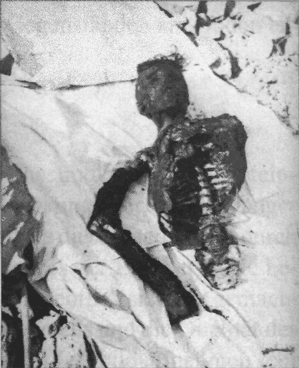
Graphic 1-12: A young victim of the Hamburg firestorm
While It was understood that the decontamination squads would work as firefighters until needed for special purposes, it should be obvious that their protective clothing, equipment, and training made them perfectly suited for activities including corpse handling, as well as in the disinfection of shelters, where for example “corpse water” (Leichenwasser) was found. [N77]
At that point the decontamination squads would be subordinated to the Sanitation Service (about 1/3 of the Nuremberg decontamination personnel were so assigned)[N135], whose duties involved not only medical care but also water purification, corpse handling, garbage disposal, pest control, and disease control. [N77f,N123f,N298ff] In fact in Nuremberg, in the last years of the war, the municipal disinfection center was used not only for the combatting of rats and flies but also for the delousing of city residents. [N123f]
The reward for these levels of sanitation prophylaxis was that German cities were untouched by epidemics throughout the war, despite the intensive destruction. One doctor, writing for the US Strategic Air Survey after was war, was “incredulous” at this fact, which he initially considered “inconceivable.” [US82] His explanation focused on three factors: first, the German people had high standards of personal cleanliness and orderliness even under the most extreme conditions, the RLB agressively pursued a program of education on personal hygiene, for which citizens were required to attend six lectures each quarter throughout the war, and finally the cooperation (Dr. Enloe calls it “docility”) [US82] of the population in such measures as boiling water after an air raid or in laying out traps during designated rat extermination campaign.
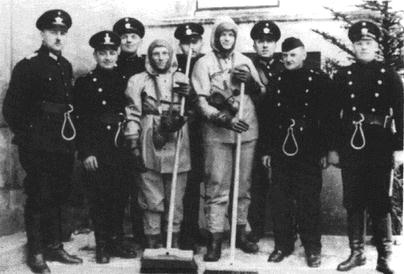
Graphic 1-13: A group of Nuremberg firefighters and decontamination workers
Nevertheless, there were some outbreaks of disease, including typhus fever, which did not appear until after “foreign laborers” had been imported from Eastern Europe where the disease was endemic (it is assumed that these foreign laborers constituted Soviet POWs and Eastern Jews).[US30] Although the foreign workers and POW's were inspected, and one assumes, deloused, twice on entering Germany, [US30f, cf. SF86] Dr. Bauer believed that the conditions of the labor camps contributed to the outbreaks, where overcrowding and lack of sanitation helped foster the disease, plus the air raids which led the civilian population to freely mix with the internees insofar as public shelters were used by both and because evacuations usually involved both. He also cited the extension of working hours and the lack of soap as contributing factors. Another likely influence was the fact that the firefighting crews frequently wound up using raw sewage in combating fires. [US63]
That the gas decontamination squads would become involved in such activities corpse handing, disinfection, vermin control, and delousing creates a number of powerful associations that point to multi-pupose roles in situations where facilities or personnel are scarce. To put it another way, the decontamination paradigm of treatment, featuring undressing, washing, and dressing in clean garments, is also the model for the handling of infectious material including the disposal of the dead, as well as for the municipal disinfection stations, and the delousing stations in concentration camps.
Most descriptions of the cleanup procedures contain not only wrenching but also fantastic descriptions, particularly when dealing with the recovery of the dead. Thus one reads of an “undulating layer of of gray ash” that are supposed to represent firestorm victims [D45], or reductions of people to puddles, or multi colored corpses, and so on. But unlike other fantastic descriptions that have emerged from the war, such descriptions have a strong documentary, forensic, and even photographic basis. After the war the United States published studies that were based on the extensive reports prepared by German doctors for the secret use of the German government, and these explain the reality of these fantastic descriptions.[US, 14, 16, bibliography p. 29]
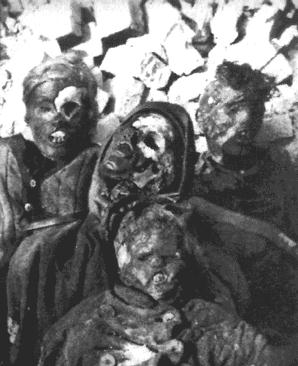
Graphic 1-14: Victims in Hamburg
The discoloration of corpses is one feature that even historians do not seem to clearly understand. Thus, David Irving, who describes corpses that are blue, orange, and green seems to think that carbon monoxide poisoning was somehow responsible [D48], while Max Hastings, who even cites the color purple, seems to think that the discoloration was due to pyrotechnics. [H319,H315] In short, the descriptions are not understood, so the authors have simply projected explanations onto the situation. And this is human nature: confronted with sights and sounds that we do not understand, we project onto the reality an explanation that accords either with what we have been taught, or what we expect, or simple guesswork.
Corpse discoloration also accounted for similar projections by the German people during the course of the war. A particular case concerns the city of Kassel after the raid of October 22, 1943. This raid, which raised a firestorm, killed less than 8,000 out of a population of 228,000, and it appears that the extensive precautions of the RLB were a major factor [D46ff]. But when many of the dead were found in their shelters days after the attack, the brilliant hues their bodies had assumed brought forth the charge of poison gas usage. To stabilize the situation, doctors conducted extensive postmortems; part of their report, dated November 1, 1943, reads as follows:
“Five of the corpses selected by the chief Police-doctor in Kassel, Herr Senior Staff Police-doctor Fehmel, were dissected at the cemetery. The corpses concerned, of people killed during the terror-raid on Kassel on 22.10.43, had been recovered from basements after several days. Closer particulars are not known. Two corpses were of the male sex and about 18-20 years old; three were of women, of which one was between about 50 and 60 years old, the other two about 30 years old. “There were no external injuries manifest on the corpses, which were in a condition of high-degree putrefaction. […] The skin was partly colored a uniform red as a result of the hemolysis which had set in, but in extensive areas it was already colored green. This green coloring is attributed to the action of the ammonium sulphide with the reduced hemoglobin, which had, of course, permeated the skin as a result of the hemolysis that had preceded it. This green coloration, the analysis of which had been specially stressed in the conferences in Kassel, is as such purely a post mortem manifestation of corpses, cannot be connected with any particular poisonous chemicals which might have been employed by the enemy during the terror-raid. ” [emphasis in original, DOD 235f]
The issue is confirmed also in mortuary literature, which clarifies the details of the Kassel report:
- The first sign of putrefaction is a greenish skin discoloration appearing on the right lower abdomen about the second or third day after death. […] Both color and smell are produced by sulphur containing intestinal gas and a breakdown of red blood cells.
- Under normal conditions, the intestinal bacteria in a corpse produce large amounts of foul-smelling gas that flows into the blood vessels and tissues. It is this gas that bloats the body, turns the skin green to purple to black, makes the tongue and eyes protrude, and often pushes the intestines out through the vagina or rectum. The gas also causes large amounts of foul-smelling blood-stained fluid to exude from the nose, mouth and other body orifices. [I42]
This last is no doubt a reference to the “Leichenwasser” or “corpse-water” described above, which occurs as the internal organs liquefy [I 43], as well as a confirmation of such descriptions as “The bottom steps were slippery. The cellar floor was covered by an eleven or twelve inch deep liquid mixture of blood, flesh and bone.” [D194]
The Kassel Report, supplemented by the mortuary literature, is important in several respects. In the first place it makes it clear that putrefaction could engender a wide variety of hues and it is possible that fire and heat even extended this palette [H315]. Thus the claim of multi-colored corpses is strikingly confirmed. Secondly, the mere issuance of the report indicates not only a widespread ignorance of the discoloration that attends dead bodies, but also the wide-spread, if not paranoid, assumption that discolored corpses must have been killed with poison gas. This will be, I believe, an important factor to consider when evaluating Allied reports from the last days of the war. But finally, the fears of the populace with regards to the danger of poison gas were in a sense justified: although the fact was not publicized at the time, many of the victims had died from carbon monoxide poisoning, which is, after all, a poison gas.
1.7. Firestorms and Carbon Monoxide
Carbon monoxide deaths were usually brought on by the fires set by the Allied bombers' incendiary bombs. To grasp the widespread nature of such deaths, we must first explain the nature of firestorms, which, in turn, will not only explain the high incidence of carbon monoxide poisoning but also some other seemingly fantastic claims pertaining to the victims of air raids.
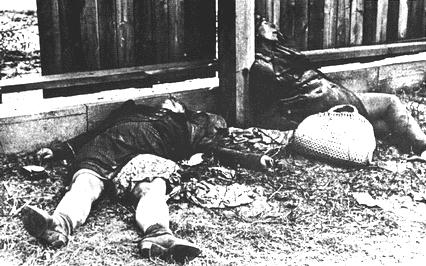
Graphic 1-15: Two Hamburg women who probably succumbed to carbon monoxide.
Firestorms are caused when a number of small fires converge into a single blaze, creating a huge conflagration which in turn sucks in oxygen at high speeds and at very high temperatures. In Hamburg, the conflagration eventually enveloped 4 1/2 square miles, developed 100 mph winds [G110], and reached temperatures of at least 600 to 800 degrees Centigrade [US19](other firestorms have been said to generate temperatures of 1,500 to 2,000 degrees Centigrade). [H314] By way of comparison it should be noted that startup temperatures for crematoria are between 600 and 700 degrees Centigrade. [I262]
Under such conditions “flash overs” or incidences of spontaneous combustion were not uncommon. [G103] Several testimonies refer to people in the street or in apparent safety in a park who would suddenly have their clothing burst into flames with no apparent trigger by way of a spark. The same conditions could be found in the cellars, many which were too hot to excavate until weeks after the raid: when a cellar was reopened, it was not uncommon for the inrush of oxygen to cause the remains of victims or coal and coke supplies to burst into flames. [US23,G167]
Carbon monoxide gas played a major role in the fatalities, particularly in incendiary raids, which were the type usually employed against population centers. Although this development was unexpected, it was soon recognized as the typical cause of death for those found in underground cellars or bunkers. [US24f] It was also a frequent cause of death for aboveground casualties, because the concentrations of the gas were so great in the streets and because heart attacks and other pathologies could result from exposure to less than lethal levels. [US24f] In Wesermunde, for example, of 210 people killed in a fire caused by an air raid, 175 perished from carbon monoxide poisoning. [US24] Of the victims of the Hamburg raid, apart from mechanical injuries, 70% were poisoned with the lethal gas. [US24] It should be noted that carbon monoxide would be generated not only from incomplete combustion but also by exploding bombs: gas from a high explosive shell would contain 60% to 70% carbon monoxide. [US24] The Germans attempted to develop a number of tests that would test carbon monoxide hemoglobin in corpses even after putrefaction. The indications are simply astonishing: while CO levels of .5% can kill, some bodies found in bomb shelters contained concentrations of up to 95%. [US25]
Aside from forensic tests, the influence of the poisonous gas could usually be detected by inspecting the posture of the remains. Because carbon monoxide is odorless, tasteless and invisible, it is possible to inhale a lethal dose without knowing it and then simply fall into a deep sleep. As a result most carbon monoxide victims showed a relaxed and unthreatened posture when found: the death was painless and came without any premonition. [US25] The authorities faced a dilemma with the results of their surveys because there were no effective preventive measures to take. As a result, the secret of the CO poison gas threat was concealed from the public. [US25] The Strategic Bombing Survey would report after the war:
In all the cities visited, carbon monoxide poisoning was regarded as the primary cause of death or injury, sometimes reaching to as much as 80% of all incendiary raid casualties. [US28]
As already suggested, cleanup after the raids was a daunting proposition. Many of the dead were lying naked in the streets, and it is known that many had stripped down to their shoes to avoid flash over.

Graphic 1-16: A Hamburg casualty literally roasted by heat, not flames.
Initially, the corpses would swell, but after a few hours “the bodies shrunk to small objects with hard brownish black skin and charring of different parts and frequently to ashes and complete disappearance.” [US22] This description, from the US Strategic Bombing Survey, shows three photographs of shelter dead, who have been between 50% to 80% cremated – the presence of hair and even clothing indicates that the destruction was achieved through high heat alone, and not through exposure to flame. [US17-21,cf. Figs. 8,14-16]
Access to the shelters could take months, and this would affect not only the body counts but also the appearance of the remains. The lack of escape movements indicated carbon monoxide poisoning in the absence of testing [US25]. The odor of putrefaction was a frequent clue to the location of the dead, except in cases where total cremation had occurred. [US23] Bodies were often found “lying in a thick greasy black mass which was without doubt melted fat tissue.” [US23] The systematic shrinkage, probably caused by the burning which removed the water mass, led the Germans to call such victims Bombenbrandschrumpfleichen or “firebombshrunken bodies” [US23]. “Many basements contained only bits of ashes and in these cases the number of casualties could only be estimated.” [US23] Of course, given the temperatures that are known to have been achieved in the course of a firestorm none of these characterizations should be surprising. As Gordon Musgrove, a highly decorated pilot for Bomber Command, has noted:
“The enormous heat seems to have turned the cellars and underground shelters into crematoria. The exits and emergency exits were surrounded by fires; steel doors, specially installed as a safety precaution, became red-hot or jammed; ceilings, weakened by excessive heat, collapsed under the weight of falling masonry; and even when they were not actually invaded by fire, many rooms were made untenable by smoke or fumes.” [G94]
Musgrove was at least half right. The inhabitants of the shelters found themselves in the abnormal situation of hiding in their basements while their buildings burned above them. As the intensive heat dried them out and turned their faces puffy and red before heat stroke set in, the deadly concentrations of carbon monoxide would slowly and silently kill them. The cellars and underground shelters were both crematoria and gas chambers combined.
Endnotes:
| [1] | “Vergasungskeller” was first published on August 6, 1996, revised on November 7, 1996, in which form it was published by the Adelaide Institute in January, 1997, and then again revised on January 7, 1997 and June 26, 1997. The article may be found on Dr. Butz' web site at: http://pubweb.acns.nwu.edu/~abutz/di/dau/vk.html |
| [2] | “Technique and Operation of German Anti-Gas Shelters: A Refutation of J. C. Pressac's 'Criminal Traces'” was first published on the CODOH website on March 23, 1997, revised April 7, 1997, further revisions April 30, 1997. It is located at http://www.codoh.com/incon/inconpressac.html |
| [3] | Pressac's magnum opus, Auschwitz: Technique and Operation of the Gas Chambers, (NY:1989) is hard to find. His The Crematoria of Auschwitz (NY:1993) is more accessible. Beginning with an article in Anatomy of the Auschwitz Death Camp (NY:1994), Gutman, Berenbaum, and Gutman, eds., he has been assisted by Robert Jan van Pelt, who has also written, with Deborah Dwork, Auschwitz: 1270 to Present (NY:1996) The general thrust of all of these interpretations is consistent. |
| [4] | An excellent treatment of the evolution of British strategic bombing thinking may be found in Hastings, op. cit., supra, esp. pp. 37-58; 106-122. |
| [5] | The Reichsluftschutzbund is usually rendered ARP or A.R.P. by British historians, apparently on the analogy with their own Air Raid Protective services. Its members would extend all the way down to the operation of each shelter: the SHD, on the other hand, worked from centralized locations. |
| [6] | On municipal disinfection centers in Germany, see “Die Umgestaltung und Vergrosserung der Desinfektionanstalt der Stadt Dortmund” in Gesundheits-Ingenieur, 27.IX.41, p. 523ff |
Bibliographic information about this document: The Journal of Historical Review, vol. 20, no. 4 (July/August 2001), pp. 15-41
Other contributors to this document: n/a
Editor’s comments: A version of this paper with less illustrations appeared in the "The Journal of Historical Review," vol. 20, no. 4 (July/August 2001), pp. 15-41, with a footnote added at the end (no. 13).
